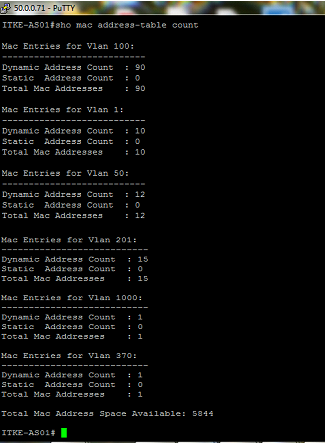Perform a show mac address-table interface on the switch that has the device(s) connected to it. Switch#show mac address-table int gi1/0/34 Mac Address Table ------------------------------------------- Vlan Mac Address Type Ports ---- ----------- -------- ----- 132 001b.78d5.a2d7 DYNAMIC Gi1/0/34 Then go to the router for the VLAN specified in the previous command and perform a show ip arp vlan| include. Router#show ip arp vlan 132| include 001b.78d5.a2d7 Internet 192.168.132.234 62 001b.78d5.a2d7 ARPA Vlan132 That will give you the IP address for the device. Though this is not exactly a solution, you can try show ip arp inspection log which will output the contents of the log buffer before the buffer was flashed. If the end device triggered some sort of log event, for instance a DHCP reject, it will be identifiable by looking the log data since the output will display interface, MAC address, and IP address on the same output line. Once again, this is not a real solution, so be mindful that it may as well not work at all.

The search tool also supports a number of keywords, which can be used to search/filter by specific characteristics. For example, an administrator can search/filter on a combination of strings, usage data, or mesh hop count. All of the available keyword options are outlined in the Search Terms section below. The switch maintains static MAC address entries that are saved in its startup configuration across reboots and flushes the dynamic entries. This example shows how to display information about the entries for the MAC address table: switch# show mac address-table. The online MAC Address Lookup is used to find the real manufacturer or vendor OUI (Organizationally Unique Identifier) of your network card based on your network card MAC address. It also allows you to find MAC address records according to the company name.
Edit: sample output from Cisco Catalyst command index pages: ` Switch# show ip arp inspection log Total Log Buffer Size: 32 Syslog rate: 10 entries per 300 seconds.
Your network grinds to a screeching halt. All the switch port lights are solid, and your only theory is that the network is under attack.
Cisco Switch Search For Specific Mac Address
What do you do? The first step is to fire up your network protocol analyzer and capture data off of the core switch. From your protocol analyzer, you see that an IP address is flooding the network with unidentifiable traffic. From the packet, you get the MAC address. Now you need to find the location of the PC.
You know that the PC must be connected to any one of a few hundred Ethernet patch panel ports in the network room; those switch ports go to ports on the Ethernet switch. If you could tell which MAC address is on which switch port, you could identify the PC and either shut down the switch port or go to the office where the PC is and shut it down.
Here are various solutions that may help you determine which device is connected to which port on your Cisco switch. An appliance solution. There are a vast number of software applications out there to help you in this situation. Here are a few that I think are worth checking out.
• Northwest Performance Software's uses SNMP to communicate with switches and to find out what is attached where. It works with different brands of switches; it shows VLAN assignments; and it exports to a spreadsheet. The standalone price for the tool is $199, and there is 15-day free trial. • ManageEngine offers the, which handles multiple brands of switches and imports cable port mappings. See the ManageEngine site for detailed pricing information.
• Netxar Technologies' maps switch ports. The cost is $99, and there is a 15-day trial download. • SolarWinds' automatically discovers and diagrams your network and what is connected where. It does more than the other packages, which is why it has a price tag of $1,995. • SolarWinds' is similar to LANsurveyor, and it's part of SolarWinds' Engineer's Toolset. The suite runs about $1,400, and the company offers a 30-day evaluation.
Cisco Switch Command Find Mac Address
Note: My search didn't turn up any free open-source products. If you know of any open source products that map switch ports, please post your recommendations in the article discussion. The Cisco IOS CLI command The easiest way to see which Ethernet MAC address is on which port is to use the show mac-address-table command.

Here is an example: switch# show mac-address-table Mac Address Table —————————————————————- Vlan Mac Address Type Ports —— —————- ———— ——- 1 0007.e9e2.2d7d DYNAMIC Fa0/5 1 0009.0f30.07e9 DYNAMIC Fa0/48 1 0009.5bbc.af04 DYNAMIC Fa0/28 1 00e0.bb2c.30d1 DYNAMIC Gi0/1 1 00e0.bb2c.3e5f DYNAMIC Gi0/1 Total Mac Addresses for this criterion: 5 Switch# (The MAC address table is truncated for brevity.) With the command, you can figure out which MAC address is on which port. When you use the command, you have to go to each switch and run the command. If the network is down, you will have to go to the console of each switch. If you had one of the applications above, you should have been able to map out which MAC address (and even which PC name) is on every switch in the network. If the scenario I describe at the beginning of the article does happen, you could reference your spreadsheet or printout of which device is connected where. Summary When your network is in crisis, it's important to know which device is connected to which switch port without having to run to the network room, hook up a console cable, and/or trace cables from switches to wall ports. By having network analysis applications and switch port mapping tools available ahead of time, you may be able to resolve the problem on your network before it actually becomes a crisis.

 0 kommentar(er)
0 kommentar(er)
